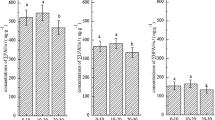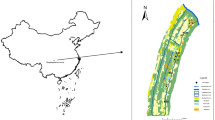Abstract
The concentrations of polycyclic aromatic hydrocarbons (PAHs) were determined in groundwater and soil profiles from upland field and paddy field in the Hunpu wastewater-irrigated area of northeast China. In the study area, the peak concentrations of total PAHs were within or just below the topsoil, and the contents decline with depth at various trend verified by the Spearman’s rank correlation test. The total PAH concentrations in upland soil layers ranged from 46.8 to 2,373.0 μg/kg (dry wt.), while the concentrations in paddy soil layers ranged from 23.1 to 1,179.1 μg/kg (dry wt.). The 16 priority PAHs were all detected in the analyzed soil samples, and naphthalene (Nap), phenanthrene (Phe), fluoranthene (Fla), chrysene (Chr), and benzo[a]pyrene (Bap) were selected for further study in terms of their vertical distributions. The concentrations of both total and individual PAHs in upland soil were generally higher than those in the corresponding layers of paddy soil. The concentrations of total and individual PAH were notably different between the corresponding horizons in upland and paddy soil were probably attribute to the different sources and properties of the PAHs and soil; different methods of soil tillage and plant growing. Special PAH compound ratios, such as phenanthrene/anthracene, fluoranthene/pyrene, LMW/HMW, and parent PAH ratios (Ant/178, Fla/202, BaA/228, and Ilp/276) were used to identify the source of soil PAHs. The data suggests that the possible sources of PAHs in the Hunpu wastewater-irrigation area are the incomplete combustion of coal, petroleum and crude oil, automobile exhausts. These sources lead to pollution of the soil and groundwater by wet/dry deposition and vertical downward migration.
Similar content being viewed by others
References
Aislabie, J., Balks, M., Astori, N., Stevenson, G., & Symons, R. (1999). Polycyclic aromatic hydrocarbons in fuel-oil contaminated soils, Antarctica. Chemosphere, 39, 2201–2207.
Alcock, R. E., Johnston, A. E., Mcgrath, S. P., Berrow, M. L., & Jones, K. C. (1993). Long-term changes in the polychlorinated biphenyl content of United Kingdom soils. Environmental Science and Technology, 27, 1918–1923.
American Chemical Society: Subcommittee on Environmental Analytical Chemistry (1980). Guidelines for data acquisition and data quality evaluation in environmental chemistry. Analytical Chemistry, 52, 2242–2249.
Baumann, P. C. (1998). Epizootics of cancer in fish associated with genotoxins in sediment and water. Mutation Research/Reviews in Mutation Research, 411, 227–233.
Berset, J. D., Kuehne, P., & Shotyk, W. (2001). Concentration and distribution of some polychlorinated biphenyls (PCBs) and polycyclic aromatic hydrocarbons (PAHs) in an ombrotrophic peat bog profile of Switzerland. Science Total Environment, 267, 67–85.
Binet, P., Portal, J. M., & Leyval, C. (2000). Dissipation of 3–6-ring polycyclic aromatic hydrocarbons in the rhizosphere of ryegrass. Soil Biology & Biochemistry, 32, 2011–2017.
Budzinske, H., Jones, I., & Bellocq, J. (1997). Evaluation of sediment contamination by polycyclic aromatic hydrocarbons in the Gironde estuary. Marine Chemistry, 58, 85–97.
Chiou, C. T., McGroddy, R. L., & Kile, D. E. (1998). Partition characteristics of polycyclic aromatic hydrocarbons on soils and sediments. Environmental Science and Technology, 132, 264–269.
Connor, T. P. (1996). Trends in chemical concentrations in mussels and oysters collected along the US coasts from 1986 to 1997. Marine Environmental Research, 41, 183–200.
Cousins, I. T., Gevao, B., & Jones, K. C. (1999). Measuring and modeling the vertical distribution of semi-volatile organic compounds in soils, 1: PCB and PAH soil core data. Chemosphere, 39, 2507–2518.
Gabcia-Falcón, M. S., Soto-González, B., & Simal-Gándara, I. (2006). Evolution of the concentrations of polycyclic aromatic hydrocarbons in burnt woodland soils. Environmental Science and Technology, 40, 759–763.
Goodin, J. D., & Webber, M. D. (1995). Persistence and fate of anthracene and benzowaxpyrene in municipal sludge treated soil. Journal of Environmental Quality, 24, 271–278.
Gschwend, P. M., & Hites, R. A. (1981). Fluxes of polycyclic aromatic hydrocarbons to marine and lacustrine sediments in the northeastern United States. Geochimica et Cosmochimica Acta, 45, 2359–2367.
Halsall, C. J., Sweetman, A. J., Barrie, L. A., & Jones, K. C. (2001). Modeling the behavior of PAHs during atmospheric transport from the UK to the Arctic. Atmospheric Environment, 35, 255–267.
Jones, K. C. (1994). Observations on long-term air±soil exchange of organic contaminants. Environmental Science Pollution, 1, 172–177.
Kipopoulou, A. M., Manoli, E., & Samara, C. (1999). Bioconcentration of polycyclic aromatic hydrocarbons in vegetables grown in an industrial area. Environmental Pollution, 106, 369–380.
Krauss, M., Wilcke, W., & Zech, W. (2000). Polycyclic aromatic hydrocarbons and polychlorinated biphenyls in forest soils: Depth distribution as indicator of different fate. Environmental Pollution, 110, 79–88.
Laor, Y., Farmer, W. J., Aochi, Y., & Strom, P. F. (1998). Phenathrene binding and sorption to dissolved and to mineral-associated humic acid. Water Research, 32, 1923–1931.
Lee, C. L., Kuo, L. J., Wang, H. L., & Hsieh, P. C. (2003). Effects of ionic strength on the binding of phenanthrene and pyrene to humic substances: Three-stage variation model. Water Research, 37, 4250–4258.
LSB (Liaoning Statistical Bureau) (1995). Liaoning Stat year book. Beijing: China Statistics Press, (in Chinese).
McCready, S., Slee, D. J., Birch, G. F., & Taylor, S. E. (2000). The distribution of polycyclic aromatic hydrocarbons in surficial sediments of Sydney Harbor, Australia. Marine Pollution Bulletin, 40, 999–1006.
Nam, J. J., Song, B. H., Eom, K. C., Lee, S. H., & Smith, A. (2003). Distribution of polycyclic aromatic hydrocarbons in agricultural soils in South Korea. Chemosphere, 50, 1281–1289.
Ockenden, W. A., Breivik, K., Meijer, S. N., Steinnes, E., Sweetman, A. J., & Jones, K. C. (2003). The global re-cycling of persistent organic pollutants is strongly retarded by soils. Environmental Pollution, 121, 75–80.
Park, S. U., In, H. J., Kim, S. W., & Lee, Y. H. (2000). Estimation of sulfur deposition in South Korea. Atmospheric Environment, 34, 3259–3269.
Pichler, M., Guggenburger, G., & Hartmann, R. (1996). Polycyclic aromatic hydrocarbons (PAH) in different forest humus types. Environmental Science and Pollution Research, 3, 24–31.
Readman, J., Mantoura, R., & Rhend, M. (1984). The physicochemical speciation of polycyclic aromatic hydrocarbons (PAH) in aquatic systems. Fresenius Z. Analytical Chemistry, 319, 126–131.
Reilley, K. A., Banks, M. K., & Schwab, A. P. (1996). Dissipation of polycyclic aromatic hydrocarbons in the rhizosphere. Journal of Environmental Quality, 25, 212–219.
Simpson, C. D., Mosi, A. A., Cullen, W. R., & Reimer, K. J. (1996). Composition and distribution of polycyclic aromatic hydrocarbons in surficial marine sediments from Kitimat Harbour, Canada. Science of the Total Environment, 181, 265–278.
Socio, H. H., Garrigue, P. H., & Ward, M. E. (2000). Origin sediments: case studies in Cotonou (Benin) and Aquitaine (France) areas. Marine Pollution Bulletin, 40, 387–396.
Song, Y. F., Chang, S. J., Li, L., Ma, X. J., & Sun, T. H. (1997). Accumulation and dynamic change of polycyclic aromatic hydrocarbons (PAHs) in wastewater irrigated soils. Chinese Journal Applied Ecology, 8, 93–98, (in Chinese).
Tam, N. F. Y., Ke, L., Wang, X. H., & Wong, Y. S. (2001). Contamination of polycyclic aromatic hydrocarbons in surface sediments of mangrove swamps. Environmental Pollution, 114, 255–263.
Tao, S., Cui, Y. H., Xu, F. L., Li, B. G., Cao, J., & Liu, W. X., et al. (2004). Polycyclic aromatic hydrocarbons (PAHs) in agricultural soil and vegetables from Tianjin. Science of the Total Environment, 320, 11–24.
Tremolada, P., Burnett, V., Calamari, D., & Jones, K. C. (1996). Spatial distribution of PAHs in the U.K. atmosphere using pine needles. Environmental Science Technology, 30, 3570–3577.
Walton, B. A., Hoylman, A. M., Perez, M. M., Anderson, T. A., Johnson, T. R., & Guthrie, E. A., et al. (1994). Rhizosphere microbial communities as a plant defense against toxic substances in soils. In T. A. Anderson, & J. R. Coats (Eds.) Bioremediation through rhizosphere technology (pp. 82–92). Washington, DC: American Chemical Society Press.
Wang, X. L., Tao, S., Dawson, R. W., & Wang, X. J. (2004). Uncertainty analysis of parameters for modeling the transfer and fate of benzo(a)pyrene in Tianjin wastewater irrigated areas. Chemosphere, 55, 525–531.
White, P. A., Rasmussen, J. B., & Blaise, C. (1998). Genotoxic substances in the St. Lawrence system I: industrial genotoxins sorbed to particulate matter in the St. Lawrence, St. Maurice and Saguenay Rivers, Canada. Environmental Toxicological and Chemistry, 17, 286–303.
Yang, S. Y. N., Connell, D. W., Hawker, D. W., & Kayal, S. I. (1991). Polycyclic aromatic hydrocarbons in air, soil and vegetation in the vicinity of an urban roadway. Science of the Total Environment, 102, 229–240.
Yuan, D. X., Yang, D. N., Terry, L. W., & Qian, Y. R. (2001). Status of persistent organic pollutants in the sediment from several estuaries in China. Environmental Pollution, 114, 101–111.
Yunker, M. B., & Macdonald, R. W. (1995). Composition and origins of polycyclic aromatic hydrocarbons in the Mackenzie River and on the Beaufort Sea shelf. Arctic, 48, 118–129.
Yunker, M. B., Macdonald, R. W., & Goyette, D. (1999). Natural and anthropogenic inputs of hydrocarbons to the Strait of Georgia. Science of the Total Environment, 225, 181–209.
Yunker, M. B., Macdonald, R. W., Vingarzan, R., Mitchell, R. H., Goyette, D., & Sylvestre, S. (2002). PAHs in the Fraser river basin: a critical appraisal of PAH ratios as indicators of PAH source and composition. Organic Geochemistry, 33, 489–515.
Yunker, M. B., Snowdon, L. R., & Mcdonald, R. W. (1996). Polycyclic aromatic hydrocarbon composition and potential sources for sediment samples from the Beaufort and Barents Seas. Environmental Science Technology, 30, 1310–1320.
Zhang, Y. J., Zhu, S. Q., Xiao, R., Wang, J., & Li, F. S. (2007). Study on Distribution of PAHs in Groundwater in Irrigation Area along the Hunhe River in Liaoning Province. Research of Environmental Sciences, 20, 8–11, (in Chinese).
Author information
Authors and Affiliations
Corresponding author
Rights and permissions
About this article
Cite this article
Xiao, R., Du, X., He, X. et al. Vertical distribution of polycyclic aromatic hydrocarbons (PAHs) in Hunpu wastewater-irrigated area in northeast China under different land use patterns. Environ Monit Assess 142, 23–34 (2008). https://doi.org/10.1007/s10661-007-9905-x
Received:
Accepted:
Published:
Issue Date:
DOI: https://doi.org/10.1007/s10661-007-9905-x




